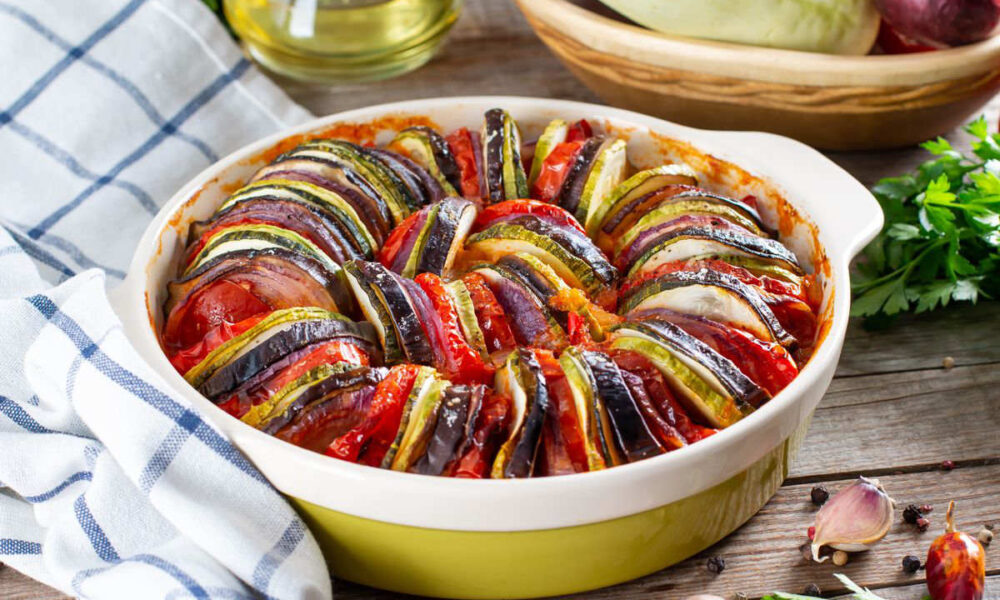Recipes
How to make a delicious baked ratatouille

Baked Ratatouille: the recipe for preparing a side dish of mixed vegetables, perfect for accompanying meat or fish main courses.
Baked ratatouille, a delicious and tasty variant of the classic French ratatouille, is generally prepared in a pan. This vegetable side dish is perfect at any time of the year (just vary the vegetables that compose it) and can be paired with main courses of any kind. You can serve your baked vegetables with eggs, cheeses, slices of homemade bread or white rice, to create a delicious single dish.
In this recipe the essential aspect is the cutting of the vegetables , which must all be the same size, and the addition of the aromatic herbs : they will give the dish its characteristic Provençal flavour. Here is the preparation step by step.
Preparation of baked vegetable ratatouille
- To prepare the baked mixed vegetable ratatouille, start by washing all the vegetables well. Then remove the ends from the courgettes and aubergines, peel the onion and potatoes, remove the stem part from the tomatoes, clean the pepper, removing the seeds and internal white parts.
- Cut all the vegetables into slices half a centimeter thick. For the pepper you can use a pastry cutter or settle for squares similar in size to the other vegetables.
- Oil a 22cm diameter baking dish and arrange the vegetables in a radial pattern starting from the outside and alternating by colour.
- Season the vegetables with oil, salt, basil and aromatic herbs of Provence. Cover with a sheet of silver paper and cook at 180°C for 1 hour . You can remove the paper for the last 15 minutes to evaporate any vegetable water and brown the vegetables.
If you want, you can spread a thin layer of tomato puree seasoned with oil and salt on the bottom of the baking dish or sauté in a pan with some onion as seen in this video .
For a simpler and quicker variant, cut the vegetables into cubes , season them with oil, salt, aromatic herbs and transfer them to the baking tray lined with baking paper. They will cook at 180°C for 45 minutes.
Conservation
We recommend keeping this vegetable side dish in the fridge for a maximum of 2-3 days , reheating it in the oven when necessary.
Origin and history of ratatouille
Rataouille is a dish of Provençal origin , particularly from the city of Nice where it is known by the name ratatouille nicoise and is traditionally prepared in a pan. The name derives from the French touiller and the Occitan ratatolha which mean to mix in clear reference to the act carried out during preparation.
It is difficult to trace the origins of the dish. According to some, it even dates back to the Roman era , although it seems quite unlikely given that many of the vegetables that compose it only arrived in European kitchens in the 19th century. Certainly throughout the 18th century it was the dish of the farmers who prepared it with the vegetables available before they spoiled.
The first written trace of the dish dates back to 1831 and is found in the Journal des sciences military des armies de terre et de mer where it was mentioned in reference to the rations of soldiers and prisoners . A few years later, in 1848, it appears in the Provençal-French dictionary where it is unflatteringly defined as “Leftovers from a meal, jumble, mash, reheated food, bad stew; soup for mice”.
Ratatouille in the world
Vegetable ratatouille has only recently returned to prominence. Everyone has at least once heard of the Pixar cartoon of the same name where a little rat prepared it. However, clever combinations of vegetables, more or less similar to this recipe, are also found in other cuisines:
- Piedmontese Ratatuia where anchovies are added to the basic recipe;
- Sicilian caponata , a delight made with fried aubergines and tomato;
- Ciambotta , a mixture of vegetables cooked with tomatoes typical of southern Italy whose ingredients vary according to the season and the areas;
- Shakshuka , a delicious dish of Berber origins imported into Israeli cuisine where the vegetables are cooked in a pan and an egg is added at the end, served with the soft yolk;
- Pisto Manchego and Pisto Andalusian which differ from each other in the vegetables used (in the second, potatoes and aubergines are also added, absent in the first);
- Xampaina , a typical Catalan recipe where pumpkin and potatoes are sometimes added;
- Duveč or Gjuwetsch widespread throughout the Balkan peninsula where olives are added to the vegetables;
- Briami in Greece and Turlu in Turkey where the vegetables are cut into cubes and cooked in the oven.
Riproduzione riservata © - WT